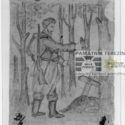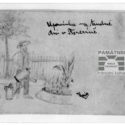In the last year of the World War I, the background of the Austro-Hungarian Empire witnessed increasingly frequent manifestations of resistance and opposition to the continuing conflict. Not only wishes to terminate this too long lasting military conflict, but also starvation, non-payment to soldiers, mistreatment and denials of soldiers’ leaves instigated riots of the 3rd Century of the 7th Rifle Regiment in Rumburk.
In the spring of 1918, František Noha became the leader of Rumburk rebels consisting mainly of Czech returnees from the former Russian captivity. With the intention to provoke a revolution, even in connection with civilians and other military units across the whole Bohemia, the rebels headed towards the town of Česká Lípa. After partial successes there, they came across a predominance of military and gendarmerie divisions loyal to the Austro-Hungarian army. Approx. 1,000 – 1,200 participants of the rebellion were defeated and largely captured.
Martial court in Rumburk sentenced main leaders of the rebellion František Noha, Stanislav Vodička and Václav Kovář to death. They were executed in the early hours of 29th May 1918 on the grounds behind the Rumburk cemetery. Another lawsuit, this time in Nový Bor, originally sentenced to death 21 defendants. However, the verdict over 14 of them was later reviewed and modified to a long heavy prison in the range of 5-10 years in the Small Fortress in Terezín.
The fate of the remaining majority of detained participants of the rebellion was sealed by their subsequent deportation to the Small Fortress. Out of the total of approx. 560 imprisoned soldiers, five of them were immediately sentenced to penal servitude in the range of 6-9 years, another 150 newcomers were sent from Theresienstadt to frontline and others to prison Bory in Pilsen. The remaining ca. 300 soldiers should stand before the Divisional Court, whose trial was set for 28th October 1918!
- Kresby účastníka rum. vzpoury V. Haise z doby věznění v MP, FAPT 1546/1,2
- Kresby účastníka rum. vzpoury V. Haise z doby věznění v MP, FAPT 1546/1,2
Living conditions of the imprisoned in the Small Fortress were literally inhuman, as testified by memories of a direct participant of the rebellion František Baťa: “Also the fortress was terrible. We got to a cell – about 30 or 20 people into one. The worst was the beginning. In the morning a few drops of black coffee, a tiny little piece of bread, dried vegetables, in the evening soups. Hunger, no one knows how terribly hungry we were… We also had lice there… We killed them, there was no disinfection. We chose a commandant, he carefully observed that everyone was picking lice and no one was slacking. We were wearing what they arrested us in – torn knees, big holes. We received nothing extra. Our straw mattresses were chipped, they looked like rags already. As a cushion I had a piece of bag and my blanket was dirty and torn. In October it was already cold.”
The establishment of the independent Czechoslovak state caused that the main trial did not take place; instead, on 30th October 1918, Czech officers brought the participants of Rumburk rebellion out of the Small Fortress to nearby Bohušovice nad Ohří. Then they returned back to Terezin, seized the arsenal and for three days and nights were on a continuous guard duty before being relieved by other units. Most of the former rebels returned back to their homes in early November.
A sort of sequel to Rumburk rebellion was a telegram from the Austrian Ministry of Defence which was delivered to the Divisional Court in Theresienstadt the last day of October. It demanded the release of rebel soldiers from custody and proposals for granting them a pardon. The formal pardon was eventually granted by the regulation of the National Committee of 5th November 1918.
Ha




